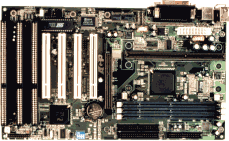Gainward's first pass through the AnandTech test lab, with their i440ZX 6IZB, was a disaster, but don't write them off just yet. They're back with a more traditional board, the 6IBA based on Intel i440BX. This board is actually older than the 6IZB, a hence has actually been through more revisions and should have given Gainward a good chance to work out some of the bugs.
New Anand Tech Report Card Rating 79/C
Do not compare newer ratings to older ones, the newer ratings are much more aggressive
| CPU Interface | Slot-1 |
| Chipset | Intel i440BX |
| L2 Cache | N/A (on-chip) |
| Form Factor | ATX |
| Bus Speeds |
50 / 66 / 75
/ 83 |
| Clock Multipliers | 3x - 6x |
| Voltages Supported | Auto Detect |
| Memory Slots | 3 168pin DIMM Slots |
| Expansion Slots | 1
AGP Slot 4 PCI Slots (4 Full Length) 3 ISA Slot (1 Shared / 3 Full Length) |
| BIOS | Award 4.51PG |
The Good

The impression given by the 6IBA after a first look is that it is appears much like any other ATX i440BX Slot-1 mainboard with no special features nor any obvious defects. The ATX specification is also closely followed with most major components strategically placed to minimize cable clutter and provide the greatest possible space to work around the board. All HDD/FDD connectors are located where they should be, right at the front of the board, so that these cables are not forced to run over the CPU and/or memory.
Marring the otherwise good layout, the ATX power connector is right behind the Slot-1 connector, forcing that cable to run over the CPU, and possibly the memory, to reach its destination. That cable clutter makes it difficult to work inside the complete system and also obstructs air flow somewhat. The board uses a standard ATX mounting format, but is fairly short - just a bit longer than an ISA slot - and should fit just fine in any ATX case.
Gainward chose to offer the now dated 4/3/1 (PCI/ISA/AGP) slot configuration that is being phased out on just about all Slot-1 motherboards. The three available DIMM slots are pretty much standard fare for an i440BX board in this class. Two fan connectors are available - one next to the CPU, and one at the front, left corner of the board. A relatively sparse four 1500uF capacitors are located immediately behind the Slot-1 connector as well as a number of 1000uF capacitors placed all over the board. The virtually standard green heatsink covers the i443BX chip and is attached via thermal tape. Betaconn connectors are used throughout the board. Although not one of the biggest makes of connectors and sockets, these get the job done fairly well and feel sturdy. DIMM slots are also no-name, but seem to be quite strong and as good as any others available today.
Although the Gainward site makes claims of 60/66/75/83/90/100/112/133 MHz FSB speeds, the 60 and 90 MHz options appear to be myths. The 60Mhz is instead replaced by an essentially useless 50MHz option. Overclocked FSB speeds are not documented in the manual at all, and are fairly well hidden under the Chipset Features Setup in the BIOS under the label "CPU Host Clock." The default is "Auto," which essentially means it selects 66 or 100MHz as indicated by the state of pin B21 - just like Intel wants motherboard manufacturers to do. The available bus speeds are also determined by the state of B21 - 100MHz and above bus speeds are intended for 100MHz CPU's and the same goes for the 50 - 83MHz settings. Fortunately, a jumper that can be used to override B21 is included right next to the i443BX chip and allow for 100MHz speeds on a 66MHz CPU. Clock multipliers are controlled via a dip switch block, with settings from 3x to 6x documented on the board via silk screening.










1 Comments
View All Comments
aditm - Thursday, December 18, 2003 - link
My Board works the same i gess ...I don't realy know what tipe it is but is made by Intel. Works greate with Klamath or Deushates CPU.
You have to try it ... even if is old but the progres made is only in numbers (logaritmical scale .. if you know what I mean).
:)